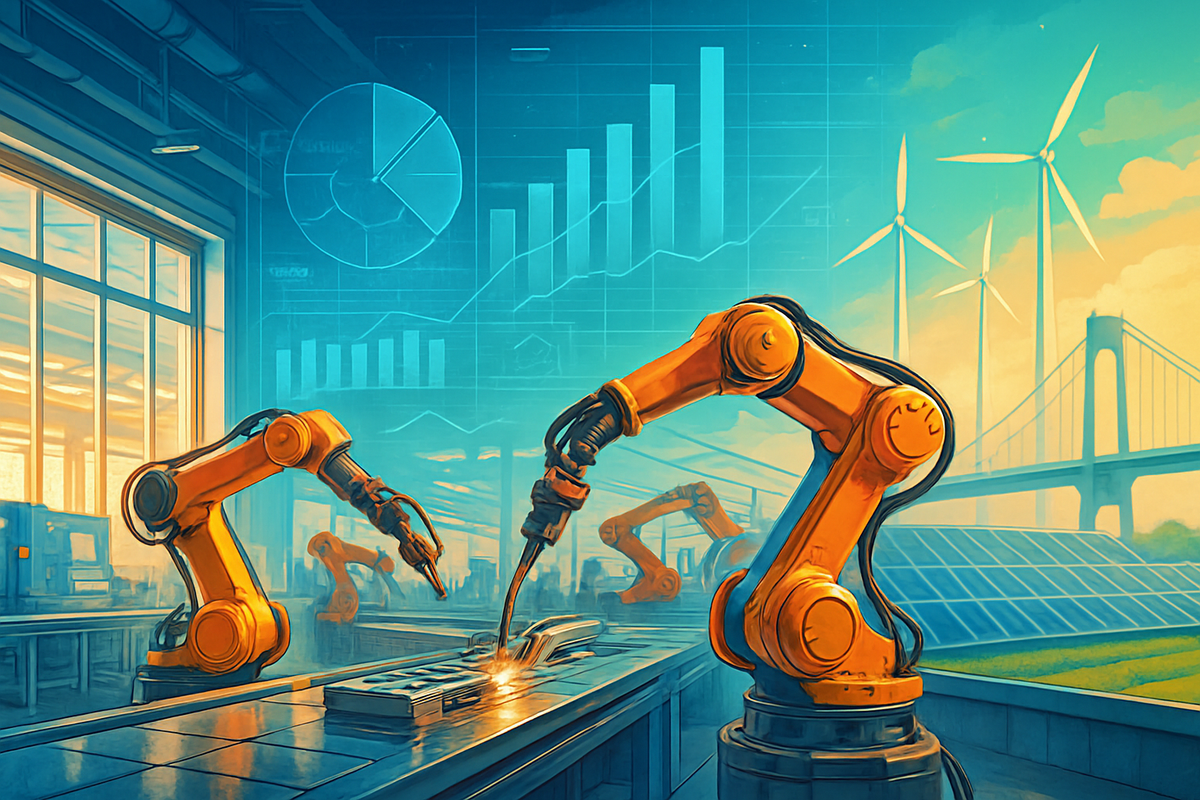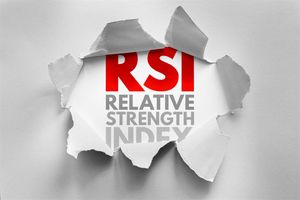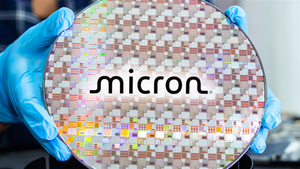
The industrial sector is currently experiencing a robust surge, demonstrating remarkable resilience and growth as of October 6, 2025. This powerful momentum is largely fueled by a global pivot towards reshoring, aggressive investments in AI-driven automation, and substantial infrastructure spending. While this trend is broad, a particularly compelling story is unfolding within companies specializing in diversified royalties and holdings, whose stable, predictable revenue streams offer a unique appeal in a dynamic market. This strength in a traditionally cyclical sector signals underlying economic resilience and has significant implications for a wide array of S&P 500-listed companies, suggesting potential shifts in investment strategies and a re-evaluation of growth drivers.
The immediate implications for the broader market are multifaceted. The industrial sector's performance often serves as a bellwether for overall economic health; its current strength indicates a cautiously optimistic outlook for a soft landing amidst fluctuating monetary policies. Furthermore, the focus on technological integration and supply chain localization within industrials could herald a broader market shift towards technologically advanced and strategically resilient businesses. Investors are keenly observing how this sustained growth translates into earnings for S&P 500 components, particularly those poised to capitalize on increased capital expenditures and automation demands.
A Deep Dive into the Industrial Sector's Resurgence
The current robust performance of the Industrial Sector is not an isolated phenomenon but rather the culmination of several strategic and economic shifts that have gained significant traction over the past two years, solidifying their impact as of October 2025. This resurgence is characterized by a concerted effort to fortify supply chains, embrace technological innovation, and rebuild critical infrastructure.
A primary driver has been the widespread reshoring and onshoring initiatives. Following the supply chain disruptions of the early 2020s, governments and corporations globally, especially in North America, have prioritized bringing manufacturing and production closer to home. This strategic pivot, often bolstered by government incentives like the Inflation Reduction Act, has ignited demand for domestic manufacturing, construction materials, engineered equipment, and components. This push has been steadily building since late 2023 and accelerated through 2024 and 2025, creating a sustained demand environment for industrial goods and services.
Simultaneously, AI-driven automation and digital transformation have become central to industrial growth. Manufacturers are making substantial investments in artificial intelligence and advanced digital technologies to enhance efficiency, enable predictive maintenance, optimize demand forecasting, and streamline overall operations. Reports indicate that technology investments constituted 30% of manufacturing companies' operating budgets in 2024, a notable increase from 23% in 2023, with cloud computing, generative AI, and 5G identified as key technologies yielding significant returns on investment. This technological embrace has transformed factory floors and operational logistics, creating a new wave of demand for automation providers and industrial software solutions.
Beyond manufacturing, significant infrastructure spending is another cornerstone of the sector's strength. Investments aimed at upgrading aging infrastructure, expanding electrification grids, and building out the foundational infrastructure for AI (such as new data centers and advanced cooling systems) are channeling substantial capital into the industrial landscape. This sustained investment, initiated in early 2024 and continuing through 2025, provides a long-term growth runway for companies involved in construction, engineering, and utility services. Furthermore, an aging global air fleet is creating substantial opportunities for aerospace-related industrial companies, driving demand for parts, maintenance, and upgrades.
Within this thriving environment, companies specializing in diversified royalties and holdings have carved out a particularly strong niche. Rather than engaging directly in manufacturing, these entities acquire predictable, often growing, royalty streams or equity stakes from a diverse portfolio of established businesses. A prime example is Diversified Royalty Corp. (TSX: DIV), which acquires royalties from North American brands such as Mr. Lube, AIR MILES, and BarBurrito. DIV has showcased robust performance, reporting a 12% increase in Q2 2024 revenue driven by higher royalty income, with Q1 2025 revenues seeing a 3.5% year-over-year increase. The company also increased its dividend by 10% in July 2025, yielding 8.4%, underscoring the stability and income-generating potential of this business model. Key players in this sub-sector benefit from diversification, mitigating risks associated with reliance on a single industry and allowing its performance to reflect broader economic trends while reducing operational exposure. The initial market reaction to these trends has been largely positive, with investor confidence bolstered by strong earnings reports and a clear pathway for continued growth. The Federal Reserve's rate cut in September 2025 further amplified investor optimism, providing a tailwind for capital expenditures across the industrial landscape.
Potential Winners and Losers in the Industrial Resurgence
The robust performance of the Industrial Sector and the specific dynamics of diversified royalties and holdings create a complex landscape of potential winners and losers among S&P 500 companies. Companies directly involved in manufacturing, automation, and infrastructure stand to gain significantly, while others might face increased competition or need to adapt their strategies.
Potential Winners:
- Automation and Robotics Companies: Firms like Rockwell Automation (NYSE: ROK) and Emerson Electric Co. (NYSE: EMR) are direct beneficiaries of the surge in AI-driven automation. As manufacturers invest heavily in digital transformation, demand for their industrial control systems, software, and automation solutions will continue to rise. Their expertise in integrating advanced technologies into factory operations positions them for sustained growth.
- Infrastructure and Construction Material Providers: Companies such as Caterpillar Inc. (NYSE: CAT) and Deere & Company (NYSE: DE), which supply heavy machinery and equipment for construction and infrastructure projects, will see increased demand. The ongoing investment in upgrading national infrastructure and building new facilities for reshoring initiatives directly boosts their order books. Similarly, material providers like Vulcan Materials Company (NYSE: VMC) could benefit from increased aggregate demand.
- Aerospace and Defense Contractors: With an aging global air fleet and continued geopolitical considerations, companies like Raytheon Technologies Corp. (NYSE: RTX) and Lockheed Martin Corporation (NYSE: LMT) are poised for sustained demand in both commercial aerospace parts and defense spending, which often falls under the broader industrial umbrella.
- Specialized Financial Services (Royalty Model Integrators): While not traditional industrials, financial firms or holding companies that recognize the stability and growth potential of royalty-based income streams might explore similar models. This could involve acquiring stakes in successful franchisors or specialized service providers. Companies like Apollo Global Management (NYSE: APO) or other private equity firms might increase their focus on acquiring businesses with stable, recurring revenue models that resemble royalty streams, potentially even within the industrial services sector.
- Industrial Software and IoT Providers: Companies developing software for industrial operations, supply chain management, and the Industrial Internet of Things (IIoT) will thrive. Firms like PTC Inc. (NASDAQ: PTC) or divisions of larger tech companies focusing on enterprise industrial solutions will see increased adoption as factories become smarter and more connected.
Potential Losers (or those needing to adapt):
- Companies with Outdated Manufacturing Processes: Industrial firms that fail to invest in automation and digital transformation risk falling behind in efficiency and cost-effectiveness. Their inability to compete with technologically advanced rivals could lead to market share erosion and reduced profitability.
- Highly Globalized Supply Chains without Reshoring Plans: Businesses heavily reliant on complex, distant supply chains that are slow to adapt to reshoring trends might face continued vulnerabilities to geopolitical disruptions, trade tariffs, and rising logistics costs, impacting their competitiveness against more localized operations.
- Traditional Industrial Services without Value-Add: Service providers that offer generic or low-value-add industrial services without incorporating new technologies (like predictive maintenance or AI-driven optimization) might find their services commoditized, leading to pricing pressures and reduced margins.
- Companies Dependent on Declining Sectors: While the overall industrial sector is strong, specific sub-sectors facing structural declines or disruptive technologies could still struggle. Companies too narrowly focused on these areas without diversification or strategic pivots could see their fortunes diminish.
The key takeaway for S&P 500 companies is the imperative to adapt. Even those not directly in the industrial sector might find opportunities to support the industrial boom through technology, logistics, or specialized financial solutions. The shift towards resilience, automation, and localized production demands strategic recalibration across the corporate landscape.
Wider Significance: Reshaping the Economic Landscape
The current industrial sector boom, spearheaded by reshoring, automation, and infrastructure spending, is far more than a cyclical upswing; it represents a fundamental reshaping of the economic landscape with broad implications across industries, regulatory frameworks, and historical precedents.
This event fits squarely into broader industry trends emphasizing supply chain resilience and technological sovereignty. The vulnerabilities exposed during the pandemic have accelerated a pre-existing trend towards de-globalization in critical sectors, favoring regional production hubs. This isn't just about manufacturing goods but also about securing intellectual property and technological advantages. The widespread adoption of AI and automation signifies a new industrial revolution, where efficiency and innovation are paramount. This trend will likely drive further consolidation in some industrial sub-sectors as companies acquire technologies and capabilities to stay competitive, while also fostering new specialized niches for innovative startups.
The potential ripple effects on competitors and partners are significant. Companies that can provide advanced robotics, industrial software, or specialized engineering services will find themselves in high demand, potentially leading to increased valuations and strategic partnerships. Conversely, competitors who lag in technological adoption or who maintain overly complex, geographically dispersed supply chains may face mounting competitive pressure, reduced market share, and increased operational costs. This could force a wave of mergers and acquisitions aimed at acquiring necessary technological capabilities or achieving economies of scale in localized production. Logistics and transportation companies will also need to adapt, shifting their focus from long-haul international routes to more efficient regional and domestic distribution networks.
Regulatory and policy implications are already evident and are expected to deepen. Governments, recognizing the strategic importance of domestic manufacturing and critical infrastructure, are likely to continue offering incentives for reshoring, R&D in automation, and green industrial initiatives. Trade policies may continue to prioritize domestic industries, potentially leading to new tariffs or non-tariff barriers that favor local production. Environmental regulations could also become a key factor, with a push for more sustainable manufacturing processes and energy-efficient industrial operations. The regulatory environment will be crucial in shaping where and how industrial capital is deployed.
Historically, periods of significant industrial transformation, such as the First and Second Industrial Revolutions, have been characterized by similar shifts: technological breakthroughs (steam power, electricity), infrastructure development (railroads, highways), and geopolitical realignments. The current era, driven by AI and data, draws parallels to these past transformations. For instance, the post-WWII era saw a massive build-out of American manufacturing and infrastructure, akin to the current reshoring and infrastructure push. However, the speed and pervasiveness of digital technologies make this transformation uniquely rapid and far-reaching. The rise of royalty and holding companies, while perhaps less historically prevalent in core manufacturing, reflects a modern financial innovation – allowing investors to gain exposure to industrial growth without direct operational risk, reminiscent of how diversified investment trusts emerged during previous economic booms to pool capital for industrial ventures. This blend of technological advancement and financial innovation underscores the profound and lasting impact this industrial resurgence is poised to have.
What Comes Next: Navigating a Transformed Industrial Landscape
The current industrial sector boom sets the stage for a period of dynamic evolution, presenting both significant opportunities and formidable challenges in the short and long term. The trajectory of this transformation will largely depend on sustained investment, policy support, and the agility of companies to adapt.
In the short-term (6-18 months), we can anticipate continued strong capital expenditures within the industrial sector. Companies will likely prioritize investments in automation technologies, supply chain optimization, and facility upgrades to capitalize on reshoring trends and enhance efficiency. This will translate into robust order books for industrial equipment manufacturers, software providers, and engineering services firms. M&A activity is expected to remain high, as companies seek to acquire specialized technologies, expand their localized production capabilities, or diversify their revenue streams, potentially through models akin to diversified royalties. The labor market in industrial hubs will likely remain tight for skilled workers, potentially driving further wage growth and accelerating the adoption of collaborative robotics to augment human labor.
Looking at the long-term (2-5 years and beyond), the industrial landscape will likely be significantly more automated, localized, and data-driven. We could see the emergence of highly resilient, regional manufacturing ecosystems, reducing global supply chain dependencies. The integration of AI will move beyond efficiency gains to enable entirely new business models, such as "lights-out" manufacturing or highly customized, on-demand production. Potential strategic pivots or adaptations required will be critical for survival and growth. Industrial companies will need to become more agile, customer-centric, and technologically adept. Those that fail to invest in continuous innovation, talent development, and sustainable practices risk obsolescence. Diversified royalty and holding companies may continue to expand their portfolios, seeking out new sectors or business models that offer stable, predictable cash flows, further cementing their role as income generators within the broader market.
Market opportunities or challenges that may emerge include the rise of specialized industrial cybersecurity firms to protect increasingly connected operational technology (OT) systems. The demand for renewable energy solutions and energy-efficient industrial processes will also create significant opportunities, aligning with broader ESG goals. However, challenges such as managing the complexity of advanced AI systems, ensuring data privacy and security, and navigating evolving regulatory frameworks will be paramount. Geopolitical tensions could still pose risks, influencing trade routes and access to critical raw materials, necessitating ongoing supply chain vigilance.
Potential scenarios and outcomes range from a "Golden Age of Industry" marked by sustained growth, innovation, and job creation in high-skilled areas, to a more fragmented landscape where only the most adaptable and technologically advanced firms thrive. A key outcome will be the redefinition of industrial competitiveness, moving beyond mere cost efficiency to encompass resilience, speed, and innovation. The success of the diversified royalty model could also inspire other sectors to explore similar asset-light, recurring-revenue strategies, further diversifying investment opportunities.
Comprehensive Wrap-Up: A New Industrial Era Dawns
The current surge in the Industrial Sector marks a pivotal moment, signaling not merely a cyclical upturn but the dawn of a new industrial era driven by strategic resilience, technological innovation, and localized production. As of October 6, 2025, the confluence of reshoring initiatives, aggressive adoption of AI-driven automation, and substantial infrastructure investments has created a robust and dynamic environment, with profound implications for public companies and investors alike.
Key takeaways from this event underscore the imperative for adaptability and strategic foresight. The pandemic-induced supply chain vulnerabilities have permanently altered corporate strategies, pushing companies towards greater self-sufficiency and regionalized operations. Simultaneously, the rapid integration of AI is transforming manufacturing processes, demanding significant capital expenditures in technology and skilled labor. The success of specialized business models, such as diversified royalties and holdings exemplified by companies like Diversified Royalty Corp. (TSX: DIV), highlights a growing appetite for stable, income-generating assets that can thrive within this evolving industrial landscape. These companies offer a unique blend of exposure to industrial growth without the direct operational risks, appealing to investors seeking both capital appreciation and consistent dividends.
Assessing the market moving forward, the industrial sector is poised for continued strength, albeit with a sharper focus on innovation and efficiency. The S&P 500 companies within this sector, particularly those in automation, infrastructure, and advanced materials, are likely to see sustained demand. The ripple effects will extend to adjacent sectors, including technology providers, logistics firms, and specialized financial services. The market will increasingly reward companies that demonstrate strong ESG credentials, particularly those investing in sustainable manufacturing and energy-efficient operations, aligning with global climate objectives.
Final thoughts on significance and lasting impact point to a more resilient, technologically advanced, and strategically independent industrial base. This shift will not only bolster economic security but also foster new waves of innovation and high-skilled job creation. The move away from purely cost-driven globalization towards a more balanced approach prioritizing resilience and proximity represents a fundamental reorientation of global commerce.
What investors should watch for in coming months includes continued earnings reports from key industrial players to gauge the sustainability of current growth rates. Keep an eye on government policy updates regarding infrastructure spending and manufacturing incentives, as these will continue to shape the investment landscape. Monitor technological advancements in AI and robotics for new applications and market disruptors. Finally, observe the M&A activity within the sector, as consolidation and strategic acquisitions will signal evolving competitive dynamics and growth areas. The industrial sector, once seen as a cyclical heavyweight, is now emerging as a dynamic engine of innovation and stability, making it a critical area for investors to track.
This content is intended for informational purposes only and is not financial advice







